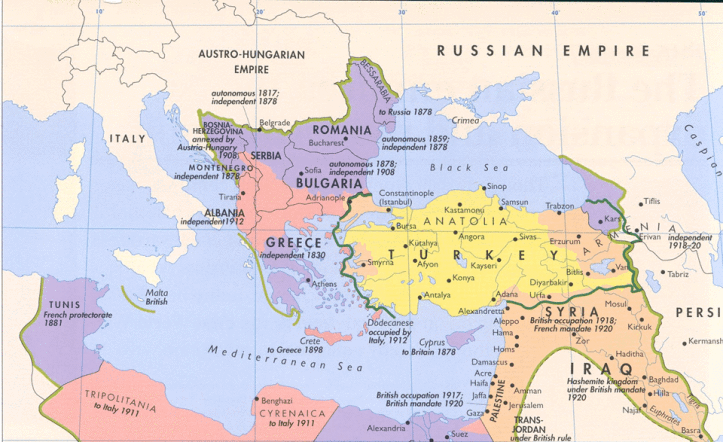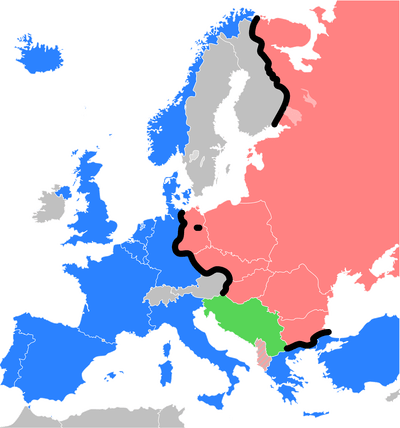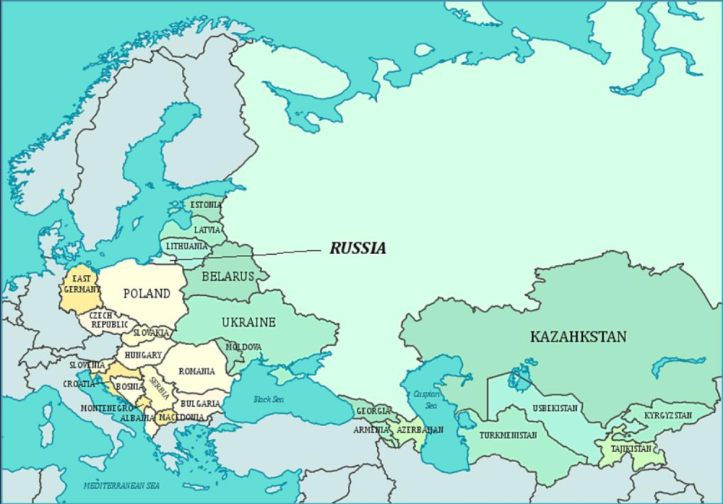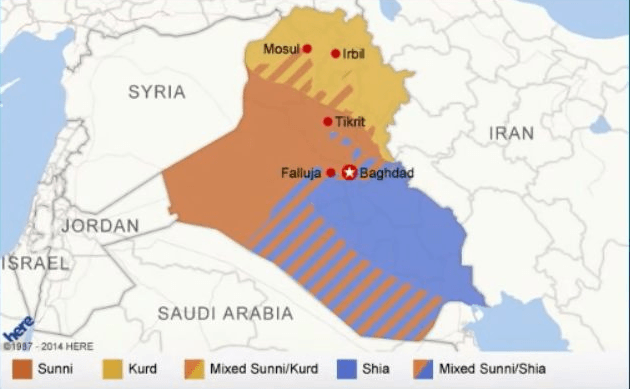Imperialism and Liberation Strategies in the Middle East

When millions of Iraqis took to the streets recently, their main slogan was “THE UNITED STATES OUT OF THE MIDDLE EAST!”
How should one analyze this?
Obviously, there are a lot of social tensions in the Middle East – class based, ethnic, religious and cultural. The region is a patchwork of conflicts and tensions that not only goes back hundreds of years, but even a few thousand. There are always many reasons to rebel against a corrupt upper class, anywhere in the world. But no rebellion can succeed if it is not based on a realistic and thorough analysis of the specific conditions in the individual country and region.
Just as in Africa, the borders in the Middle East are arbitrarily drawn. They are the product of the manipulations of imperialist powers, and only to a lesser extent products of what the peoples themselves have wanted.
During the era of decolonization, there was a strong, secular pan-Arab movement that wanted to create a unified Arab world. This movement was influenced by the nationalist and socialist ideas that had strong popular support at the time. King Abdallah 1 of Jordan envisaged a kingdom that would consist of Jordan, Palestine and Syria. Egypt and Syria briefly established a union called the United Arab Republic. Gaddafi wanted to unite Libya, Syria and Egypt in a federation of Arab republics. In 1958, a quickly dissolved confederation was established between Jordan and Iraq, called the Arab Federation. All these efforts were transient. What remains is the Arab League, which is, after all, not a state federation and not an alliance. And then of course we have the demand for a Kurdish state, or something similar consisting of one or more Kurdish mini-states. Still, the most divisive product of the First World War was the establishment of the state of Israel on Palestinian soil. During the First World War, Britain’s Foreign Minister Arthur Balfour issued what became known as the Balfour Declaration, which «… view with favour the establishment in Palestine of a national home for the Jewish people.»
But what is the basis for all these attempts at creating states? What are the prerequisites for success or failure?
The imperialist powers divide the world according to the power relations between them
Vladimir Lenin gave the best and most durable explanation for this, in his essay «Imperialism – the highest stage of capitalism«. There, he explained five basic features of the era of imperialism:
- The concentration of production and capital has developed to such a high stage that it has created monopolies which play a decisive role in economic life;
- The merging of bank capital with industrial capital, and the creation, on the basis of this “finance capital”, of a financial oligarchy;
- The export of capital as distinguished from the export of commodities acquires exceptional importance;
- The formation of international monopolist capitalist associations which share the world among themselves; and
- The territorial division of the whole world among the biggest capitalist powers is completed.
But Lenin also pointed out that capitalist countries are developing unevenly, not least because of the uneven development of productive forces in the various capitalist countries. After a while, there arises a discrepancy between how the world is divided and the relative strength of the imperialist powers. This disparity will eventually force through a redistribution, a new division of the world based on the new relationship of strength. And, as Lenin states:
“The question is: what means other than war could there be under capitalism to overcome the disparity between the development of productive forces and the accumulation of capital on the one side, and the division of colonies and spheres of influence for finance capital on the other?“
The two world wars were wars that arose because of unevenness in the power relationships between the imperialist powers. The British Empire was past its heyday and British capitalism lagged behind in the competition. The United States and Germany were the great powers that had the largest industrial and technological growth, and eventually this misalignment exploded. Not once, but twice.
Versailles and Yalta
The victors of the First World War divided the world between themselves at the expense of the losers. The main losers were Germany, Austria-Hungary, Russia (the Soviet Union) and the Ottoman Empire. This division was drawn up in the Versailles treaty and the following minor treaties.
Europe after the Versailles Treaties (Wikipedia)
This map shows how the Ottoman Empire was partitioned:
At the end of World War II, the victorious superpowers met in the city of Yalta on the Crimean peninsula in the Soviet Union. Roosevelt, Churchill and Stalin made an agreement on how Europe should be divided following Germany’s imminent defeat. This map shows how it was envisaged and the two blocs that emerged and became the foundation for the Cold War. Note that Yugoslavia, created after Versailles in 1919, was maintained and consolidated as «a country between the blocs». So it is a country that carries in itself the heritage of both the Versailles- and Yalta agreements.
The fateful change of era when the Soviet Union fell
In the era of imperialism, there has always been a struggle between various great powers. The battle has been about markets, access to cheap labor, raw materials, energy, transport routes and military control. And the imperialist countries divide the world between themselves according to their strength. But the imperialist powers are developing unevenly.
If a power collapses or loses control over some areas, rivals will compete to fill the void. Imperialism follows the principle that Aristotle in his Physics called horror vacui – the fear of empty space.
And that was what happened when the Soviet Union lost the Cold War. In 1991, the Soviet Union ceased to exist, and soon the Eastern bloc was also history. And thus the balance was broken, the one that had maintained the old order. And now a huge area was available for redivision. The weakened Russia barely managed to preserve its own territory, and not at all the area that just before was controlled by the Soviet Union.
“Never has a so large area been open for redivision. It was the result of two horrible world wars that anew was up for grabs. It could not but lead to war.” (Pål Steigan 1999)
“Never has a so large area been open for re-division. It was the result of two horrible world wars that anew was up for grabs. It could not but lead to war.” Map: Countries either part of the Soviet Union, Eastern Bloc or non-aligned (Yugoslavia)
When the Soviet Union disintegrated, both the Yalta and Versailles agreements in reality collapsed, and opened up the way for a fierce race to control this geopolitical empty space.
This laid the foundation for the American Geostrategy for Eurasia, which concentrated on securing control over the vast Eurasian continent. It is this struggle for redistribution in favor of the United States that has been the basis for most wars since 1990: Somalia, the Iraq wars, the Balkan wars, Libya, Ukraine, and Syria.
The United States has been aggressively spearheading this, and the process to expand NATO eastward and create regime changes in the form of so-called «color revolutions» has been part of this struggle. The coup in Kiev, the transformation of Ukraine into an American colony with Nazi elements, and the war in Donbass are also part of this picture. This war will not stop until Russia is conquered and dismembered, or it has put an end to the US offensive.
So, to recapitulate: Because the world is already divided between imperialist powers and there are no new colonies to conquer, the great powers can only fight for redistribution. What creates the basis and possibilities for a new division is the uneven development of capitalism. The forces that are developing faster economically and technologically will demand bigger markets, more raw materials, more strategic control.
The results of two terrible wars are again up for grabs
World War I caused perhaps 20 million deaths, as well as at least as many wounded. World War II caused around 72 milliondeaths. These are approximate numbers, and there is still controversy around the exact figures, but we are talking about this order of magnitude. The two world wars that ended with the Versailles and Yalta treaties thus caused just below 100 million dead, as well as an incredible number of other suffering and losses. Since 1991, a low-intensity «world war» has been fought, especially by the US, to conquer “the void». Donald Trump recently stated that the United States have waged wars based on lies, which have cost $ 8 trillion ($ 8,000 billion) and millions of people’s lives. So the United States’ new distribution of the spoils has not happened peacefully.
The Rebellion against Sykes-Picot
In the debate around the situation in the Middle East, certain people that would like to appear leftist, radical and anti-imperialist say that it is time to rebel against the artificial boundaries drawn by the Sykes-Picot and Versailles treaties. And certainly these borders are artificial and imperialist. But how leftist and anti-imperialist is it to fight for these boundaries to be revised now?
In reality, it is the United States and Israel that are fighting for a redistribution of the Middle East. This is the basis underlying Donald Trump’s «Deal of the Century», which aims to bury Palestine forever, and it is stated outright in the new US strategy for partitioning Iraq.
Again, this is just an updated version of the Zionist Yinon plan that aimed to cantonize the entire Middle East, with the aim that Israel should have no real opponents and would be able to dominate the entire region and possibly create a Greater Israel.
It is not the anti-imperialists that are leading the way to overhaul the imperialist borders from 1919. It is the imperialists. To achieve this, they can often exploit movements that are initially popular or national, but which then only become tools and proxies in a greater game. This has happened so many times in history that it can hardly be counted. Hitler’s Germany exploited Croatian nationalism by using the Ustaša gangs as proxies. From 1929 to 1945, they killed hundreds of thousands of Serbs, Jews and Roma people. And their ideological and political descendants carried out an extremely brutal ethnic cleansing of the Krajina area and forced out more than 200,000 Serbs in their so-called Operation Storm in 1995. Hitler also used the extreme Ukrainian nationalists of Stepan Bandera’s OUN, and after Bandera’s death, the CIA continued to use them as a fifth column against the Soviet Union.
The US low-intensity war against Iraq, from the Gulf War in 1991 to the Iraq War in 2003, helped divide the country into enclaves. Iraqi Kurdistan achieved autonomy in the oil-rich north with the help of a US «no-fly zone». The United States thus created a quasi-state that was their tool in Iraq. Undoubtedly, the Kurds in Iraq had been oppressed under Saddam Hussein. But also undoubtedly, their Iraqi «Kurdistan» became a client state under the thumb of United States. And there is also no doubt that the no-fly zones were illegal, as UN Secretary General Boutros Boutros-Ghali admitted in a conversation with John Pilger.
And now the United States is still using the Kurds in Northern Iraq in its plan to divide Iraq into three parts. To that end, they are building the world’s largest consulate in Erbil. What they are planning to do, is simply «creating a country».
As is well known, the United States also uses the Kurds in Syria as a pretext to keep 27 percent of the country occupied. It does not help how much the Kurdish militias SDF and PYD invoke democracy, feminism and communalism; they have ended up pleading for the United States to maintain the occupation of Northeast Syria.
Preparations for a New World War
Israel and the US are preparing for war against Iran. In this fight, they will develop as much «progressive» rhetoric as is required to fool people. Real dissatisfaction in the area, which there is every reason to have, will be magnified and blown out of all proportion. «Social movements» will be equipped with the latest news in the Israeli and US «riot kits» and receive training and logistics support, in addition to plenty of cold hard cash.
There may be good reasons to revise the 1919 borders, but in today’s situation, such a move will quickly trigger a major war. Some say that the Kurds are entitled to their own state, and maybe so. The question is ultimately decided by everyone else, except the Kurds themselves. The problem is that in today’s geopolitical situation, creating a unified Kurdistan will require that «one» defeats Turkey, Syria, Iraq and Iran. It’s hard to see how that can happen without their allies, not least Russia and China, being drawn into the conflict. And then we have a new world war on our hands. And in that case, we are not talking about 100 million killed, but maybe ten times as much, or the collapse of civilization as we know it. The Kurdish question is not worth that much.
This does not mean that one should not fight against oppression and injustice, be it social and national. One certainly should. But you have to realize that revising the map of the Middle East is a very dangerous plan and that you run the risk of ending up in very dangerous company. The alternative to this is to support a political struggle that undermines the hegemony of the United States and Israel and thereby creates better conditions for future struggles.
It is nothing new that small nations rely on geopolitical situations to achieve some form of national independence. This was the case, for example, for my home country Norway. It was France’s defeat in the Napoleonic War that caused Denmark to lose the province of Norway to Sweden in 1814, but at the same time it created space for a separate Norwegian constitution and internal self rule. All honor to the Norwegian founding fathers of 1814, but this was decided on the battlefields in Europe. And again, it was Russia’s defeat in the Russo-Japanese War that laid the geopolitical foundation for the dissolution of the forced union with Sweden almost a hundred years later, in 1905. (This is very schematically presented and there are many more details, but there is no doubt that Russia’s loss of most of its fleet in the Far East had created a power vacuum in the west, which was exploitable.)
Therefore, the best thing to do now is not to support the fragmentation of states, but to support a united front to drive the United States out of the Middle East. The Million Man March in Baghdad got the ball rolling. There is every reason to build up even more strength behind it. Only when the United States is out, will the peoples and countries in the region be able to arrive at peaceful agreements between themselves, which will enable a better future to be developed. And in this context, it is an advantage that China develops the «Silk Road» (aka Belt and Road Initiative), not because China is any nobler than other major powers, but because this project, at least in the current situation, is non-sectarian, non-exclusive and genuinely multilateral. The alternative to a monopolistic rule by the United States, with a world police under Washington’s control, is a multipolar world. It grows as we speak. The days of the Empire are numbered. What this will look like in 20 or 50 years, remains to be seen.
*
Note to readers: please click the share buttons above or below. Forward this article to your email lists. Crosspost on your blog site, internet forums. etc.
Translated by Terje Maloy
Pål Steigan is a Norwegian veteran journalist and activist, presently editor of the independent news site Steigan.no.






